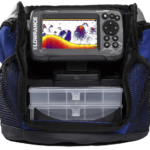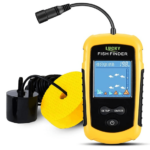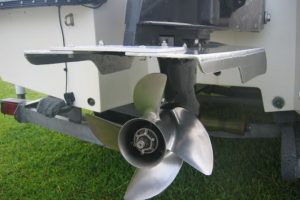A transducer is a crucial component of a fish finder that helps anglers locate fish underwater. It works by converting electrical energy into sound waves, which are then transmitted through the water.
These sound waves bounce off objects in the water, including fish, and the transducer then receives the echoes, which are converted back into electrical signals and displayed on the fish finder’s screen.
Transducers come in different shapes and sizes, and each is designed to work with a specific type of fish finder.
Some transducers are designed to be mounted on the transom of a boat, while others are mounted on the trolling motor. Some are even designed to be mounted inside the hull of a boat.
The type of transducer you need will depend on the type of fish finder you have and the type of fishing you plan to do.
Understanding how a transducer works and choosing the right one for your fish finder can make all the difference in your fishing success.
With the right transducer, you can get a clear and accurate picture of what’s happening underwater, which can help you find and catch more fish.
Understanding Transducers in Fish Finders

A transducer is an essential component of any fish finder. It is responsible for transmitting and receiving sonar signals that bounce off objects underwater, providing information about the depth, structure, and location of fish.
In simple words, a transducer is a tool that converts energy from one form to another. In the case of fish finders, it converts electrical signals into sound waves that are then transmitted into the water.
Types of Transducers
Fish finders usually come with three types of transducers: through-hull, in-hull, and transom mount. Through-hull transducers are the most common type and are installed through a hole drilled in the hull of the boat.
In-hull transducers are installed inside the hull of the boat and are in contact with the water. Transom mount transducers are mounted on the transom of the boat and are in direct contact with the water.
Transducer Frequencies
Transducers also come in different frequencies. The most common frequencies are 50 kHz and 200 kHz. High-frequency transducers (200 kHz) provide better resolution and are ideal for shallow water fishing. Low-frequency transducers (50 kHz) are better for deep water fishing and can penetrate through thick vegetation and debris.
Transducer Materials
Transducers are made of different materials such as plastic, bronze, and stainless steel. Plastic transducers are the most affordable and are ideal for small boats. Bronze transducers are more durable and are ideal for larger boats. Stainless steel transducers are the most durable and can withstand harsh marine environments.
In addition to the above, some fish finders use CHIRP technology, which stands for Compressed High-Intensity Radiated Pulse. CHIRP transducers emit a range of frequencies, providing better target separation and image resolution.
Beam angle is another important factor to consider when choosing a transducer. A wider beam angle provides a larger coverage area but less detail, while a narrower beam angle provides more detail but less coverage.
Installation and Mounting Options
When it comes to installing a transducer on a fish finder, there are several mounting options available, including through-hull installation, transom mount installation, and in-hull installation.
Through-Hull Installation
Through-hull mounting involves installing the transducer directly into the hull of the boat. This type of installation is ideal for larger boats and vessels that require a permanent and secure mounting solution. Through-hull installations can be made of bronze, plastic, or stainless steel, depending on the type of boat and the transducer being used.
Transom Mount Installation
Transom mounting involves attaching the transducer to the back of the boat, or transom, using brackets and screws. This type of installation is the most common and is suitable for most boats. Transom mounts are adjustable and can be moved up or down to adjust the depth of the transducer.
In-Hull Installation
In-hull mounting involves mounting the transducer inside the hull of the boat. This type of installation is ideal for boats with a flat or slightly curved hull. In-hull installations require a special adhesive to bond the transducer to the hull.
When choosing a mounting option, it is important to consider the type of boat, the transducer being used, and the depth of the water. Each mounting option has its own advantages and disadvantages, and it is important to choose the one that best suits your needs.
Selecting the Right Transducer for Your Needs

When it comes to selecting the right transducer for your fish finder, there are a few things to consider. In this section, we will discuss the compatibility of transducers with fish finders, the importance of beam angle, and understanding power requirements.
Compatibility with Fish Finders
Compatibility is an important factor to consider when selecting a transducer for your fish finder. Not all transducers are compatible with all fish finders, so it is important to check the manufacturer’s specifications before making a purchase. Some popular fish finder brands include Garmin, Raymarine, Lowrance, Simrad, and Furuno.
Determining the Correct Beam Angle
Another important factor to consider when selecting a transducer is the beam angle. The beam angle is the width of the sonar signal that is emitted from the transducer.
A narrow beam angle will provide more detail, but it will cover less area. A wider beam angle will cover more area, but it will provide less detail. The correct beam angle will depend on your fishing style and the depth of the water you will be fishing in.
Understanding Power Requirements
The power requirements of a transducer are also an important consideration. The power of a transducer is measured in watts, and the higher the wattage, the more powerful the transducer.
However, a higher wattage transducer will also require more power to operate. It is important to check the power requirements of your fish finder and ensure that the transducer you select is compatible with your fish finder’s power output.
Optimizing Fish Finder Performance
To get the most out of a fish finder, it is important to optimize its performance. This can be achieved by adjusting the transducer settings and interpreting sonar readings.
Adjusting Transducer Settings
The transducer is the part of the fish finder that sends and receives sonar signals. It is important to adjust the settings of the transducer to ensure that it is working optimally. One of the most important settings to adjust is the frequency of the sonar waves.
The frequency of the sonar waves determines the depth at which the fish finder can detect objects. Lower frequencies can detect objects at greater depths, while higher frequencies are better suited for shallower waters.
Another setting to adjust is the chirp technology. Chirp technology sends out a range of frequencies, which can provide a more detailed picture of what is below the surface. The resolution of the display is also important. A higher resolution display can provide a clearer picture of what is below the surface.
Interpreting Sonar Readings
Interpreting the sonar readings is crucial to understanding what is below the surface. The fish finder displays information in the form of sonar readings. These readings can be used to determine the depth of the water, the location of fish, and the structure of the bottom.
It is important to understand the sound waves that are being used by the fish finder. Sound waves travel differently in different water depths, and understanding this can help to interpret the sonar readings more accurately.
Additional Considerations for Anglers and Boaters

When choosing a transducer for a fish finder, there are a few additional considerations that anglers and boaters should keep in mind. In this section, we’ll cover some important factors to consider when selecting a transducer, as well as some tips for maintaining and caring for your transducer.
Fishing Tactics and Transducer Selection
Different types of fishing require different types of transducers. For example, if you’re an offshore angler, you’ll want a transducer that can handle high speeds and deep water. On the other hand, if you’re a freshwater angler who likes to fish in shallow water, a transducer with a lower frequency may be more appropriate.
Another factor to consider is the type of fishing tackle you use. If you frequently use downriggers or planer boards, you’ll want to select a transducer that can handle the extra weight and resistance.
Maintenance and Care for Transducers
Proper maintenance and care for your transducer can help ensure that it performs optimally for years to come. Here are a few tips to keep in mind:
- Clean your transducer regularly using a soft, damp cloth. Avoid using harsh chemicals or abrasive materials that could scratch the surface.
- Check the mounting hardware and cables periodically to ensure that they are secure and in good condition.
- If you notice any damage or wear and tear, address it promptly to prevent further damage.
By following these tips, you can help ensure that your transducer continues to provide accurate readings and reliable performance. Additionally, if you’re in the market for a new transducer, consider Airmar technology, which is known for its high-quality, reliable products.
Final Thoughts
A transducer is an essential component of any fish finder. It is a tool that converts energy from one form to another, and it is responsible for sending and receiving sonar signals that help detect fish schools under the surface. The type of transducer that you use will have a significant impact on how your fish finder performs.
There are several types of transducers, including transom mount, in-hull, and thru-hull transducers. Each type has its own set of advantages and disadvantages, and the choice of transducer will depend on your specific needs and preferences.
For example, transom mount transducers are the most common type, and they are relatively easy to install and use. In-hull transducers are mounted inside the hull of the boat and are ideal for boats with low deadrise angles. Thru-hull transducers are mounted on the bottom of the boat and provide the best performance, but they are also the most difficult to install.
When choosing a transducer, it is important to consider the frequency of the sonar signal. Low-frequency signals can penetrate deeper into the water, but they provide less detail. High-frequency signals provide more detail, but they do not penetrate as deep. Dual-frequency transducers provide the best of both worlds, but they are also the most expensive.
In conclusion, a transducer is a critical component of any fish finder, and choosing the right one is essential for getting the most out of your fishing experience. By considering the type of transducer, the frequency of the sonar signal, and other factors, you can find the perfect transducer for your needs and preferences.








![Read more about the article Parts of a Boat [Motorboat, Sailboat, Fishing Boat]](https://boatinggeeks.com/wp-content/uploads/2021/03/parts-of-a-boat-300x200.jpg)
